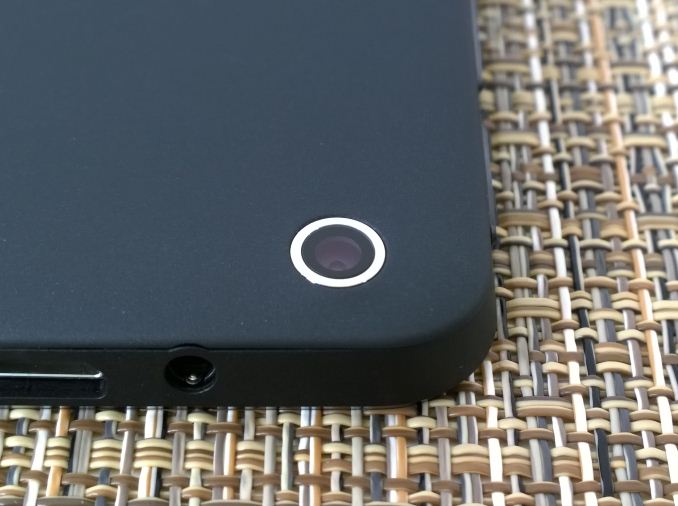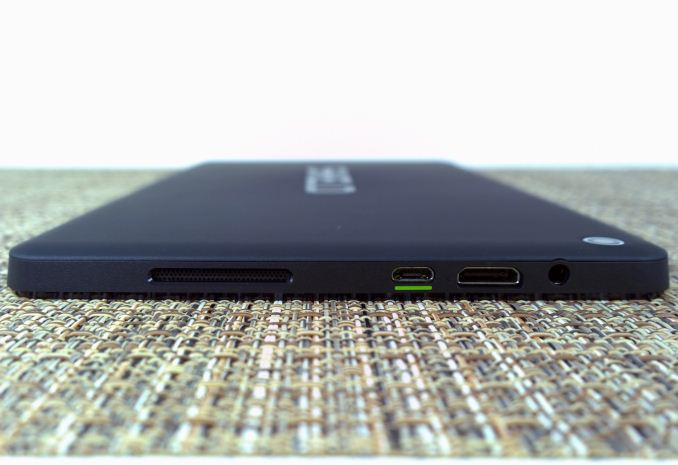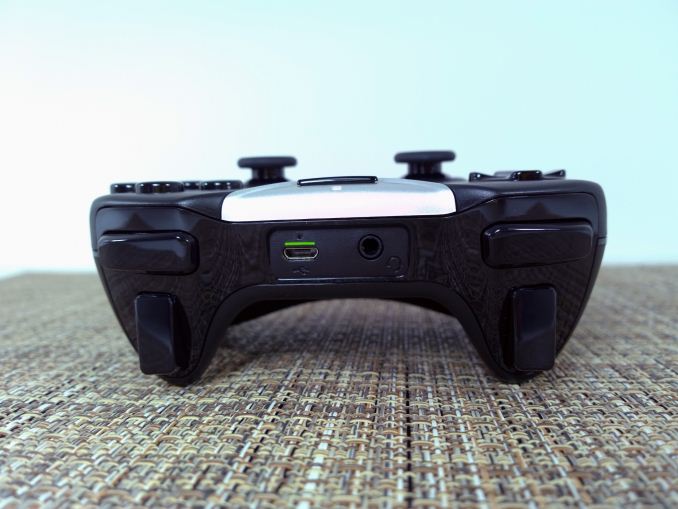The NVIDIA SHIELD Tablet Review
by Joshua Ho on July 29, 2014 9:00 AM ESTFinal Words
If I’m honest, it’s hard for me to review tablets. While I academically understand why people like tablets, I’ve never really found a use for them. They’re less comfortable to use in bed than a phone, I usually can’t type on a tablet as quickly as I do on a phone due to the size and weight, and in general it’s hard to justify a tablet when a phone is generally much more versatile. So when I got the Shield Tablet, I didn’t really know what to expect. While I have a Shield Portable, I don’t spend much time gaming on it, especially when I have a desktop that can do it much better. I came away from my experience pleasantly surprised.
Over the past five days, I’ve learned a lot about this device. As a tablet, it’s good. The material design and industrial design is acceptable and the device itself is quite ergonomic but it doesn’t blow me away. However, given the need to meet cost constraints, the matte plastic feel is really all that’s necessary and I don’t have any complaints in this area.
In the other fundamentals, we see a bit of a checkered pattern. In the display, the static contrast is quite high, and the calibration is good, but the gamut of the display doesn’t cover sRGB. This would definitely be an area that should be improved for the next generation. Although there are some compelling reasons to go with smaller color gamut, it ends up as a disadvantage when compared to other general-purpose tablets. The display is still perfectly usable, but it's a bit more washed out than I'd like.
In battery life, we see that the Shield Tablet ends up doing relatively well in web browsing, but for intensive gaming the tablet can’t spend much time away from an outlet before draining the battery completely. This is likely to be an unavoidable tradeoff, given the immense amounts of performance that Tegra K1 provides versus the power costs of doing so on a 28nm process. Anyone that has lived with a gaming laptop should understand this. As said before, it’s also possible to improve battery life from the 2.5 hour figure if the game is light enough to allow the GPU to run at lower frequencies. Barring that, NVIDIA has included options to cap the maximum frame rate of the display and reduce maximum CPU frequencies.
Otherwise the only other notable difficulty I’ve run into is with the stylus. Generally speaking it works well enough, but the stylus requires a bit more lift between words than I’m used to and keeping it from feeling fully natural. But I will be the first to admit that this is a minor issue at best.
Outside of the tablet itself, the gaming features are compelling. The larger 8” display and massively improved SoC on the Shield Tablet made for a far better gaming experience than what I had on Shield Portable. There’s a great deal of potential in ShadowPlay on a tablet, as while screen recording is nothing new in PCs this feature is often difficult to enable on Android. This is before we talk about the effects that live video encoding has on UI performance. ShadowPlay has managed to enable easy screen recording on a mobile device and do so without significantly impacting performance.
Meanwhile GameStream and GRID are even better on the larger screen that the tablet provides. While it was cool to play PC games on the Shield Portable, the size of the display simply made some elements too small to reasonably see. Now, there are no such issues. GameStream and GRID are definitely a lot of fun to use, especially if the game is well-adapted to playing on a controller.
Ultimately though, I feel that the native game library is the most important aspect of this device. While there are plenty of solid single player games, multiplayer games are few and far between. I still feel that multiplayer is where Shield has the strongest potential because it makes the difference between tens of hours per game and hundreds, even thousands of hours per game. There are definitely signs that this aspect of the ecosystem will improve in the near future as Trine 2 supports local multiplayer and War Thunder on Shield Tablet should be able to play online against console and PC players.
After getting through all of these observations over the past five days, I’ve come to realize that even though it’s not the perfect tablet, all of the features that this device brings to the table right now would be enough for me to seriously consider buying one. If NVIDIA manages to get enough multiplayer titles with an active community on Shield Tablet, there wouldn’t be a need to stop and consider at all. As someone that has spent the past few years never considering a tablet purchase at all, the Shield Tablet is the first ARM tablet that I would seriously think about buying.
The SHIELD Tablet is 299 USD for the 16GB WiFi model, 399 USD for the 32 GB LTE model. Each controller is 59.99 USD and the cover is 39.99 USD. While the 16GB model is 70 dollars more expensive than the Nexus 7 equivalent, the gap narrows to 50 dollars for the 32GB LTE model. Given the sheer amount of utility that this device brings to the table, the pricing is definitely set at the right place.














174 Comments
View All Comments
name99 - Tuesday, July 29, 2014 - link
OK. I guess there are situations where that makes sense. Thx.6cef - Tuesday, July 29, 2014 - link
if "closer to 6504k is better", then you should order the graph by the absolute magnitude of the difference between each devices white point and that ideal value.duh.
kyuu - Wednesday, July 30, 2014 - link
+1kae - Wednesday, July 30, 2014 - link
I'll echo the question of a few previous comments... What is the compatibility of the controller with other Android Devices and PC's supporting WiFi Direct? I'm still rocking the Xbox360 Wireless, but if I can ditch the stupid USB dongle and go direct, I'd do it in a heartbeat. Double the function if it also communicates with my N5, and I'm sold.Anyone know? The documentation only talks about how fast WiFi direct is, but not if NVidia is using some proprietary drivers, or if it will work with any device. My hope is the latter.
wintermute000 - Wednesday, July 30, 2014 - link
it always beats me why the big two don't write decent cross platform drivers. Why on earth did Sony not write a good windows and/or android driver for dualshock for example. Easy money (how much can it possibly cost to write a joypad driver) to instantly create a new market.TheJian - Wednesday, July 30, 2014 - link
proprietary, but nvidia is working with google to get it into AndroidL, so should start to work elsewhere soon, if not at least everything shield that comes along and K1 devices etc. A sale is a sale and you're not giving up a lot here, but mapping software (& community profile uploads for mapping to certain games) goes with it so maybe it would be giving away too much.victorson - Wednesday, July 30, 2014 - link
"Although there are some compelling reasons to go with smaller color gamut." Could someone please help out and say what could those reasons be? I'm really curious, always thought there were no such reasons.UpSpin - Wednesday, July 30, 2014 - link
Take a look at the color gamut of white LEDs. You'll see they're blue ones with a phosphor film to produce 'white' light:http://en.wikipedia.org/wiki/Light-emitting_diode#...
However the color reproduction is lacking, especially on cheap white LEDs (the ones you can buy on eBay for example) The more accurate colors you want (high CRI) the more difficult it becomes, they become more expensive and also less efficient. To reproduce all visible colors the best method is to use three separate LEDs, a blue, green and red one. Such a setup is highly inefficient however.
So all NVidia did was using cheap white LEDs to cut costs but also to enhance battery life at the cost of a poor CRI.
theNiZer - Wednesday, July 30, 2014 - link
Great review, very helpfull !cashnmillions - Wednesday, July 30, 2014 - link
Ok so the display isn't phenomenal. Like anyone can really tell the difference between a few pixels. It's an 8" tablet, it doesn't need resolution above 720p to look good. The GPU capabilities are phenomenal, I remember when the Snapdragon and Adreno destroyed the competition about a year ago, this destroys that. I think it's an awesome piece of hardware, I plan to get one, just kind of sucks that the controller is $60. I wonder if I can use an XBOX 360 controller with it like I can on my Nexus 7.